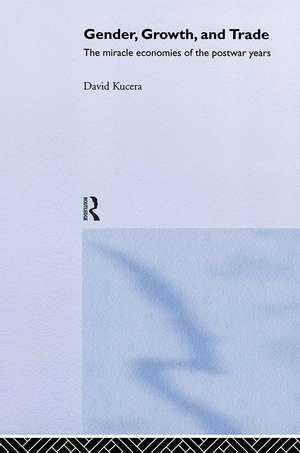Gender, Growth and Trade: The Miracle Economies of the Post-war Years: Routledge Frontiers of Political Economy
Autor David Kuceraen Limba Engleză Hardback – 14 dec 2000
Din seria Routledge Frontiers of Political Economy
-
 Preț: 309.90 lei
Preț: 309.90 lei -
 Preț: 309.79 lei
Preț: 309.79 lei -
 Preț: 316.03 lei
Preț: 316.03 lei -
 Preț: 310.95 lei
Preț: 310.95 lei - 9%
 Preț: 866.82 lei
Preț: 866.82 lei -
 Preț: 309.12 lei
Preț: 309.12 lei -
 Preț: 311.61 lei
Preț: 311.61 lei -
 Preț: 286.99 lei
Preț: 286.99 lei -
 Preț: 327.83 lei
Preț: 327.83 lei -
 Preț: 311.87 lei
Preț: 311.87 lei -
 Preț: 302.76 lei
Preț: 302.76 lei - 9%
 Preț: 938.48 lei
Preț: 938.48 lei -
 Preț: 152.67 lei
Preț: 152.67 lei -
 Preț: 151.97 lei
Preț: 151.97 lei -
 Preț: 318.54 lei
Preț: 318.54 lei -
 Preț: 317.95 lei
Preț: 317.95 lei -
 Preț: 310.01 lei
Preț: 310.01 lei -
 Preț: 326.49 lei
Preț: 326.49 lei -
 Preț: 155.44 lei
Preț: 155.44 lei -
 Preț: 309.79 lei
Preț: 309.79 lei -
 Preț: 328.76 lei
Preț: 328.76 lei -
 Preț: 281.72 lei
Preț: 281.72 lei -
 Preț: 286.58 lei
Preț: 286.58 lei -
 Preț: 386.12 lei
Preț: 386.12 lei -
 Preț: 353.78 lei
Preț: 353.78 lei -
 Preț: 325.09 lei
Preț: 325.09 lei -
 Preț: 310.55 lei
Preț: 310.55 lei -
 Preț: 387.03 lei
Preț: 387.03 lei -
 Preț: 324.87 lei
Preț: 324.87 lei -
 Preț: 312.86 lei
Preț: 312.86 lei -
 Preț: 374.16 lei
Preț: 374.16 lei -
 Preț: 329.09 lei
Preț: 329.09 lei -
 Preț: 348.22 lei
Preț: 348.22 lei - 28%
 Preț: 1047.06 lei
Preț: 1047.06 lei - 18%
 Preț: 1169.45 lei
Preț: 1169.45 lei - 18%
 Preț: 1555.17 lei
Preț: 1555.17 lei - 18%
 Preț: 1048.43 lei
Preț: 1048.43 lei - 18%
 Preț: 1059.84 lei
Preț: 1059.84 lei - 31%
 Preț: 767.47 lei
Preț: 767.47 lei - 18%
 Preț: 731.92 lei
Preț: 731.92 lei - 28%
 Preț: 822.54 lei
Preț: 822.54 lei - 18%
 Preț: 1796.21 lei
Preț: 1796.21 lei - 29%
 Preț: 1184.91 lei
Preț: 1184.91 lei - 18%
 Preț: 1120.23 lei
Preț: 1120.23 lei - 15%
 Preț: 700.95 lei
Preț: 700.95 lei - 18%
 Preț: 1116.31 lei
Preț: 1116.31 lei - 25%
 Preț: 299.52 lei
Preț: 299.52 lei
Preț: 1110.74 lei
Preț vechi: 1354.56 lei
-18% Nou
Puncte Express: 1666
Preț estimativ în valută:
212.56€ • 230.81$ • 178.55£
212.56€ • 230.81$ • 178.55£
Carte tipărită la comandă
Livrare economică 22 aprilie-06 mai
Preluare comenzi: 021 569.72.76
Specificații
ISBN-13: 9780415198622
ISBN-10: 0415198623
Pagini: 240
Dimensiuni: 152 x 229 x 19 mm
Greutate: 0.5 kg
Ediția:1
Editura: Taylor & Francis
Colecția Routledge
Seria Routledge Frontiers of Political Economy
Locul publicării:Oxford, United Kingdom
ISBN-10: 0415198623
Pagini: 240
Dimensiuni: 152 x 229 x 19 mm
Greutate: 0.5 kg
Ediția:1
Editura: Taylor & Francis
Colecția Routledge
Seria Routledge Frontiers of Political Economy
Locul publicării:Oxford, United Kingdom
Public țintă
PostgraduateRecenzii
'The book provides useful insights into the determinants of women's labour force participation - a crucial issue in the current debate on sustaining the welfare state in the context of declining fertility and population ageing, and the resulting shrinkage of the economically active population.' - International Labour Review
Cuprins
1. Unemployment, Labor Market Flexibility and Women as a Buffer Workforce Introduction: defining labor market flexibility Part 1. Evidence on the relationship between labor market flexibility and unemployment Part 2. Unemployment and labour flexibility in Japan Conclusion 2. Women's Integration into the Workforce Introduction: the buffer, job segregation, and substitution hypotheses Foreign workers in Germany as a buffer workforce Women as a buffer workforce and the job segregation hypothesis in sectors and manufacturing industries Comparing patterns of gender segregation Conclusion 3. Industrial Relations and Labor Market Institutions Introduction: combining high and low road strategies in Japan Lifetime employment and nenko earnings in Japan: persisting institutions Temporary employment as a stepping stone and buffer Part-time employment from demand and supply sides Women and unions Conclusion Appendix: Policies supporting the employment of mothers; Maternity leave policies; Child care provisions 4. Foreign Trade, Employment and Earnings Introduction: skills bias and gender bias Part 1. Foreign trade and men and women's employment Part 2. Foreign trade and diverging gender wage gaps in Germany and Japan Conclusion 5. German Reunification Introduction: the question of convergence Women's employment in East Germany and persisting inequalities After the wall: women's high unemployment and demographic shocks Conclusion
Descriere
This book provides a comparative account of women's employment in Japan and Germany. Kucera examines women's role as a flexible, contingent workforce in two of the world's foremost industrialised economies.
















